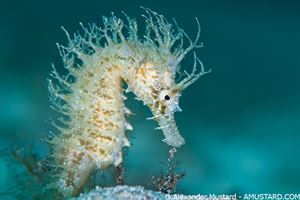Seahorses have a very typical shape and are easily recognized even by people who do not practice scuba diving. Their name comes from the bizarre head, recalling that of horses even though they are absolutely not related to each other. At Capo Galera Diving Center we are lucky to host some of these amazing creatures right below in our bay.
Seahorses show some interesting features, even though they are not fast swimming animals, in order to fight waves or strong currents, their prehensile tail is used to attach themselves to rocks or algae.Each eye can move independently, same as chamaleons, so that they can easily spot the small crustaceans they hunt continuously, swallowing them with the long, straw like, teethless snout. The lucky scuba diver will be able to witness feeding scenes by lightning the seahorse with a lamp and patiently waiting.In order to escape from predators, seahorses count on mimicry: some species have soft tufts in order to seem like algae, moreover the coloration is highly variable and can change in every individual, although very slowly.
Even their biology is interesting: after a long courtship of gentle touching and sometime intertwined tails, the female lays its eggs in a ventral puch of the male and he fertilizes them internally. He carries the eggs until they hatch, then releases fully formed, miniature seahorses into the water. This feature is typical of seahorses and the closely related pipefish only.
Some tens of species are known worldwide: they are strictly protected, but endangered by habitat loss, pollution and collection for traditional oriental medicine.Only two species are recourded as endemic in the Mediterranean: the long snouted seahorse Hippocampus guttulatus and the short snouted seahorse Hippocampus hippocampus; a third species, the sea pony Hippocampus fuscus, comes from the Red Sea, but nowadays it has only been recorded in the eastern Mediterranean basin.

Type: Sygnatidae fish
Diet: Small crustaceansAverage life span in the wild: 1 to 5 years
Size: 1.5 to 35 cm
Fact: Seahorses have no stomach. Food passes so quickly through their digestive system that they must eat constantly to survive.